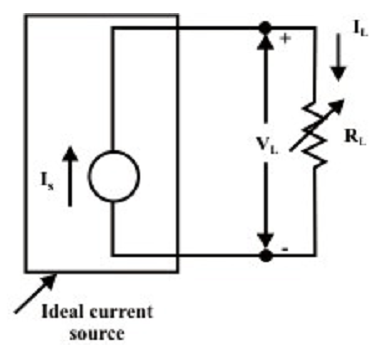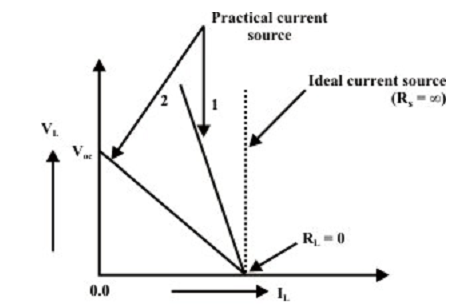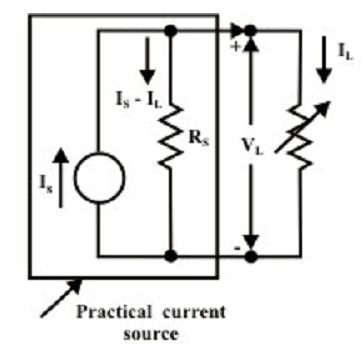Ideal and Practical Current Sources
• Another two-terminal element of general use in circuit modeling is ‘current source’ as represented in figure below. An ideal current source that is symbolized by a model in figure below, is a device which delivers a constant current to any load resistance connected across it, no matter what the terminal voltage is build up across the load (that is, independent of the voltage across its terminals).

Figure: Ideal current source with variable load
It can be observed from model of the current source that the current flowing from the source to the load is always constant for any load resistance that is, whether RL is small (i.e., VL is small) or RL is large (i.e., VL is large). The vertical dashed line in figure below symbolizes the I − characteristic of ideal current source. In practice, whenever a load is connected across a practical current source, one can examine that the current flowing in load resistance is decreased as the voltage across the current source’s terminal is raised, by raising the load resistance RL. As the distribution of source current in two parallel paths completely depends on the value of external resistance which connected across the source (i.e., current source) terminals. This fact can be realized by introducing a parallel resistance RS in parallel with the practical current source IS, as shown in second figure below. The dark lines in the first figure shown below illustrate the V-I characteristic (i.e., load-line) of practical current source. The slope of the curve symbolizes the internal resistance of the source. One can exert KCL at the top terminal of the current source in the second figure below to acquire the expression as follows.


Figure: V-I characteristics of practical current source

Figure: Practical current source with variable load
The open circuit voltage and the short-circuit current of the practical current source are offered by VOC = ISRS and IShort = IS correspondingly. It can be observed from the Figure of V-I characteristics of practical current source that source 1 has a higher internal resistance than source 2 and the slope the curve points out the internal resistance RS of the current source. Therefore, source 1 is much closer to the ideal source. More particularly when the internal source resistance RS ≥ 100 RL then the source acts nearly as an ideal current source